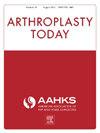Silk Fibroin Closure Eliminates the Incidence of Allergic Contact Dermatitis Compared to Cyanoacrylate Mesh in Total Joint Arthroplasty
IF 1.5
Q3 ORTHOPEDICS
引用次数: 0
Abstract
Background
Allergic contact dermatitis (ACD) from adhesive wound closure systems has garnered particular attention for its potential role in increasing wound complications in total joint arthroplasty (TJA). This study, performed at a high-volume orthopaedic specialty hospital, investigates the incidence of wound complications among 2 adhesive systems: a cyanoacrylate mesh (CM) adhesive and a silk fibroin (SF) adhesive.
Methods
All TJAs from January 2019 to April 2024 with at least 6 wks postoperative follow-up were retrospectively reviewed. Demographics and surgical outcomes were collected and analyzed. Statistical analyses were performed using Fisher’s exact tests and t-tests.
Results
A sample size of 170 CM and 85 SF subjects was calculated to achieve a power of 80%. Of the 257 patients identified (172 CM and 85 SF), 46.7% were females and 53.3% were males, with a mean age of 65.3 ± 9.0 years and a mean body mass index of 28.0 ± 4.6. Bivariate analyses revealed no significant differences in demographics or comorbidities between the CM and SF cohorts, except for frequency of American Society of Anesthesiologists 1 classification (3.9% vs 1.7%; P = .011). The CM cohort exhibited a significantly higher incidence of ACD (6.4% vs 0%; P = .018), while differences in all other clinical outcomes were nonsignificant.
Conclusions
There is a very low incidence of wound complications in TJA when using the SF adhesive for wound closure. There was a statistically significant increase in ACD when using the CM adhesive. SF adhesives appear to be a superior wound closure option to consider in patients undergoing TJA.
求助全文
约1分钟内获得全文
求助全文
来源期刊

Arthroplasty Today
Medicine-Surgery
CiteScore
2.90
自引率
0.00%
发文量
258
审稿时长
40 weeks
期刊介绍:
Arthroplasty Today is a companion journal to the Journal of Arthroplasty. The journal Arthroplasty Today brings together the clinical and scientific foundations for joint replacement of the hip and knee in an open-access, online format. Arthroplasty Today solicits manuscripts of the highest quality from all areas of scientific endeavor that relate to joint replacement or the treatment of its complications, including those dealing with patient outcomes, economic and policy issues, prosthetic design, biomechanics, biomaterials, and biologic response to arthroplasty. The journal focuses on case reports. It is the purpose of Arthroplasty Today to present material to practicing orthopaedic surgeons that will keep them abreast of developments in the field, prove useful in the care of patients, and aid in understanding the scientific foundation of this subspecialty area of joint replacement. The international members of the Editorial Board provide a worldwide perspective for the journal''s area of interest. Their participation ensures that each issue of Arthroplasty Today provides the reader with timely, peer-reviewed articles of the highest quality.
 求助内容:
求助内容: 应助结果提醒方式:
应助结果提醒方式:


